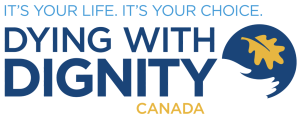7.6 Dying with Dignity Advocacy Organizations

As discussed at the start of this chapter, notions of dying with dignity or death with dignity are tied to the quality of the dying process. These terms, however, have also become synonymous with the right to assisted death movement. Dying with Dignity (n.d.-b) is a Canadian based organization, while Death with Dignity (n.d.-b) is a U.S. organization. Both are leaders in their respective countries in terms of end-of-life advocacy, education, and support. Their emphasis is on choice and the right to choose one’s own good death, whether that be a natural death from age, disease/illness, accident, or medically assisted dying.
Click the following link to learn about the history of Dying with Dignity Canada:
Dying wth Dignity Canada: How far we have come. Dying with Dignity Canada.
Dying with Dignity Canada (n.d.-b) is also fighting for the rights of people to receive MAiD in the location of their choice. Currently, there are many institutional and community settings (e.g., care homes, hospices, religious oriented hospitals) that will not permit MAiD on their premises. This means that people in very fragile states, near the end of life, must be relocated if they wish medical assistance in dying. In response, there is an initiative to create MAiD suites, where people can receive assistance in dying in a supportive, home-like setting (e.g., MAiDHouse, and funeral home MAiD suites).
Click the following link to learn about the challenges that people seeking MAiD can face:
When a hospital denies MAiD: A forced transfer story.

